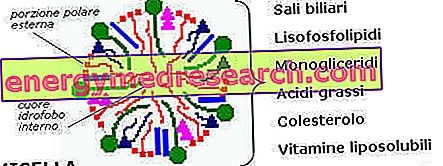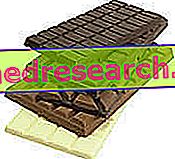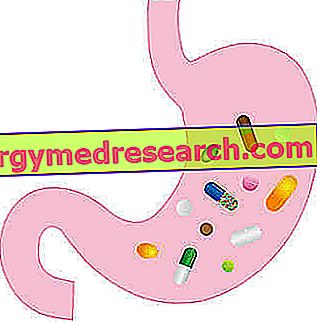See also: malabsorption
micelle
At the level of the small intestine, pancreatic lipases digest fatty acids, giving rise to many fine aggregates called micelles. Within these small "transporters", essential for conveying the lipophilic molecules in the cells responsible for their absorption, are the products of lipid digestion:
cholesterol, vitamins, bile salts
monoglycerides and fatty acids resulting from the digestion of triglycerides
lysophospholipids and fatty acids deriving from the digestion of phospholipids

Fat absorption occurs mainly in the middle section of the small intestine, called jejunum.
Nutrient absorption
Thanks to their small size and the solubilizing action of bile salts, the micelles are soluble in the aqueous environment.
Arrived near the microvilli that cover the outer surface of the intestinal villi (brush border), the micelles release their contents. The individual components, by virtue of their lipophilicity, are able to cross the plasma membrane of the brush border and penetrate into the enterocytes.
At this point these substances, to be poured into the plasma or lymph, must necessarily come together and form lipoproteins, real agglomerates made up of a lipid portion and a protein part.
- In the cytoplasm of the enterocyte monoglycerides are combined with fatty acids to reform triglycerides (exactly the opposite of what happened in the stomach and especially in the initial tracts of the small intestine). Similarly, lysophospholipids are combined with fatty acids, giving rise to phospholipids.
- At this point a lipoprotein is produced, called chylomicrone and made up of a lipid heart (formed by triglycerides, phospholipids, cholesterol and vitamins), surrounded by protein molecules. This sort of mantle, thanks to the water solubility conferred by the proteins, increases the solubility degree of the chylomicrone in the aqueous medium.
After exiting the enterocyte with a mechanism of exocytosis, the chylomicrons pass into the interstitial fluid and from there to the lymphatic vessels inside the villus. Acids and bile salts are instead absorbed in the ileum (terminal part of the small intestine), conveyed into the bloodstream and transported to the liver, where they are recycled and secreted again with bile.
- Recall that, unlike lipids, all other intestinal absorption products (carbohydrates, amino acids, water, mineral salts and water-soluble vitamins) enter directly into the blood capillaries by simple diffusion, facilitated or active transport. Also the short and medium chain fatty acids, which represent only a small part of the lipids contained in food, reach the blood capillaries directly.
- As far as mineral salts are concerned, some, like sodium, chlorine, potassium and phosphorus, are easily absorbed, while bivalent cations, such as calcium, iron and zinc, are absorbed with greater difficulty. This explains why the lack of these minerals is so common and how often their integration in health and sports is proposed.
- The water-soluble vitamins, with the exception of B12 which requires the intrinsic factor secreted by the gastric glands, are absorbed with relative ease.
After being fed by the intestinal cells the chylomicrons are conveyed into the lymphatic circulation, which at the level of the succlavy veins flows into the bloodstream. It is thought that this obligatory, apparently useless path is linked to the permeability of chylomicrons. These large agglomerates, by virtue of their important dimensions, would in fact encounter many difficulties in crossing the blood capillaries inside the villus.
In summary, the chylomicrons pass into the blood only after being absorbed into the intestine and transported by the lymph to the blood.
- All the other nutrients absorbed in the intestinal villi are poured into the blood capillaries which, meeting in the venules, flow into a vessel called the mesenteric vein, in turn connected into a larger duct directed to the liver and called the portal vein. Therefore, with the exception of lipids, all the products of intestinal absorption encounter the liver as the first organ, an essential structure for their metabolism. It receives blood from two imported vessels: the hepatic artery, which comes from the aorta and the portal vein, coming from the intestine.
The arterial blood directed to the liver is transported by the hepatic artery which, once reached the organ, branches off into many small arterioles and capillaries. As mentioned a few lines ago, the liver also receives blood from the portal vein that carries nutrient-rich blood (except lipids) from the intestine.
The venous blood leaves the liver through the hepatic vein, flows into the inferior cava and from there reaches the heart and the systemic cycle.
The chylomicrons
Once in the vicinity of the muscle or fat cells, the chylomicrons carried by the blood slow down their movement and bind to sites on the capillary wall. Thanks to this bond, chylomicrone yields part of the triglycerides to the tissues (especially to the muscular and adipose tissues), reducing its lipid load.
Subsequently, the chylomicrons poor in triglycerides (called leftovers) reach the liver, penetrating inside it. The hepatocytes, after having incorporated them, digest the outer shell of a proteic nature, freeing their lipid content (residual triglycerides, cholesterol, phospholipids and fat-soluble vitamins).
Triglycerides are partly used as a reserve and partly degraded for energy purposes in glycerol plus fatty acids. The latter, after entering the Krebs cycle, will be further degraded to water and carbon dioxide, with the formation of ATP.
Phospholipids can be used for energy or structural purposes, in the latter case they participate in the renewal of plasma membranes.
The fat-soluble vitamins are partly released into the circulation and partly stored in the liver, to cope with any vitamin deficiencies. To cite an example, the reserves of vitamin A in a healthy and well-nourished organism are such as to guarantee the proper functioning of the body for a period of one or two years.
Cholesterol, essential for supporting various metabolic functions, is partly used as a constituent of plasma membranes and partly as a precursor of steroid hormones and bile salts. Unlike other nutrients, cholesterol cannot be transformed or degraded for energy purposes. Any excess can be eliminated only through the bile which, poured into the liver, favors its elimination with the faeces.



